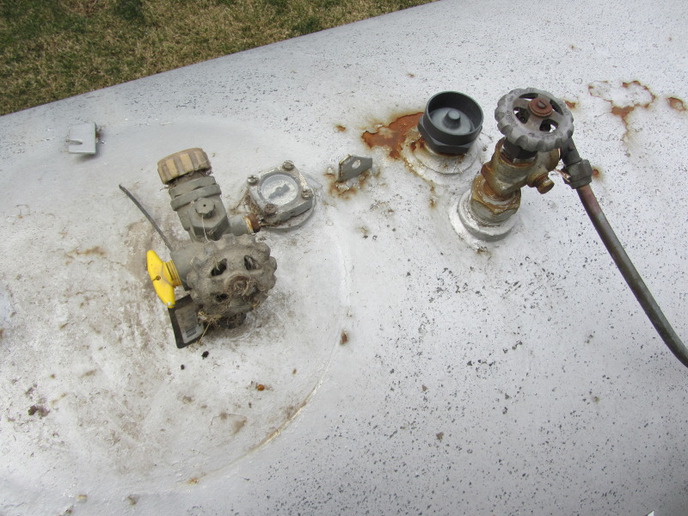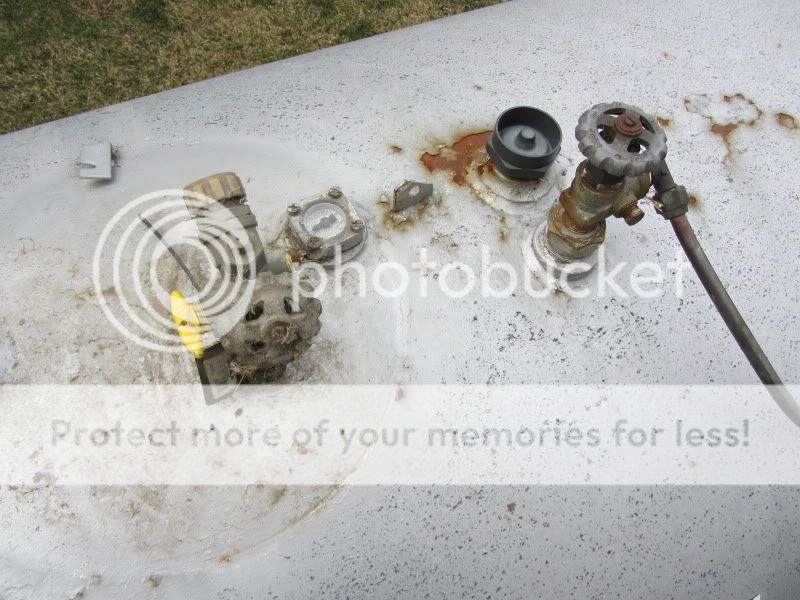MT pockets
Member
Mr. Glennster,
Your picture prompted me to post a description of the valves, their proper names, and their purpose. Every time this subject has come up on here, I have thought about doing this, as there always seems to be some confusion about propane tanks. This is going to be kind of long, so if this doesn"t interest some of you, take a break or something. I don"t know how to include the picture of the tank here, so maybe someone else could do that.
In the picture, starting on the left, this valve is for vapor withdrawal only. The wheel valve would turn the gas off and on to your house. The bright yellow plug is screwed in to a Prest-O-Lite or POL fitting. It is exactly like the threads on an acetylene tank valve. This valve communicates with the vapor space of the tank. The dull yellow cap covers the vapor return line fitting which would be connected to the delivery truck to equalize the vapor pressure while filling the tank. The threads are one and one-quarter inch Acme. The little valve with the tiny hole right below the vapor return, is the 80% outage gage. It has a small dip tube that extends down to the 80% liquid level. When filling the tank, the outage valve is opened a small amount. It will expel vapor until the tank is 80% full, then liquid will appear. This is assuming the tank is level, which by law it should be. The rusty plug screwed in to the side of the multi-valve is where a 0-300 psi gauge would be fitted. This is 1/4 inch in NPT (National Pipe Taper). The hole behind the plug is very small. If the gauge were broken off or damaged, you would be able to plug the hole or replace the gauge under pressure. The metal tab with the slotted hole is to mount a regulator to the tank. The next thing to the right of this is the liquid level gauge. It is a float pipe gauge and will work in any tank the same diameter as this one. Next, the little tab sticking up is for securing the dome cover or lid. (It is against the law to lock the dome cover, by the way). Next is the Pressure Relief Valve or pop-off valve. It communicates with the vapor space of the tank. In operation, if the tank pressure rises above a safe level, this valve will open completely and instantly to relieve the pressure in the tank. When the pressure is back to a safe preset level, the pop-off valve closes instantly. Next is the Liquid Withdrawal Valve. That is the valve screwed into the tank. Not the wheel valve. The liquid withdrawal valve has a dip tube that goes to the bottom of the tank. Also built in to the liquid withdrawal valve is an Excess Flow Valve and a spring loaded check valve. The Excess Flow Valve is a type of spring loaded safety valve. It is held open by a spring, and would be closed by an outflow of liquid gas above a normal or safe range. If everything above the tank fitting were broken off accidentally, the Excess Flow Valve would shut and restrict the outflow of liquid gas to a small amount. The Excess Flow Valve Disc has a tiny bleed hole to allow the valve to reset once the cause of the excess flow condition has been remedied and the valve plugged by some means. The wheel valve screwed into the excess flow valve is made for the purpose of liquid withdrawal. It also has an excess flow valve built in to it. If the wheel valve was broke off or the piping connected to it ruptured, this excess flow valve would in turn close. This is the valve that a filler hose would be connected to for the purpose of filling a tractor tank, combine tank, cotton picker tank, motor vehicle fuel tank, or some other use. Excess flow valves are sized and designed according to their flow rates and also whether they protect liquid flow or vapor flow. The wheel valve is NPT both male and female. The plug screwed into the hole in the side of the wheel valve is plugging a hole that should have a pressure relief valve installed in it. There is a reason for that also. The filler valve is not in view in this picture. It is 1 3/4 in. Acme threads for the filler hose fitting and NPT in to the tank. It communicates with the vapor space only and also has an excess flow valve in to it. If the threads were broken off while a filler hose was attached, the check valve would be broken off also, but the excess flow valve would still restrict the flow of gas to a small amount. There is an odorant added to the Liquified Petroleum Gas for the purpose of leak detection. If you have flies, you have a leak. It may be very tiny but it is there. Some of the older propane tanks had the liquid withdrawal from the bottom only. The tank came from the factory with the opening plugged with a 3/4 in NPT. To attach a filler hose the tank had to be completely empty and the plug removed. A liquid withdrawal valve exactly like the one in the picture was installed with the little pop off valve installed in it. To answer your original question, the valve servicing your grain dryer is the only valve for the purpose of liquid withdrawal on this tank.
Dictated by Steve Norwood, Texarkana, TX
Typed by Debbie Norwood (cause Steve can"t type, very well)
Your picture prompted me to post a description of the valves, their proper names, and their purpose. Every time this subject has come up on here, I have thought about doing this, as there always seems to be some confusion about propane tanks. This is going to be kind of long, so if this doesn"t interest some of you, take a break or something. I don"t know how to include the picture of the tank here, so maybe someone else could do that.
In the picture, starting on the left, this valve is for vapor withdrawal only. The wheel valve would turn the gas off and on to your house. The bright yellow plug is screwed in to a Prest-O-Lite or POL fitting. It is exactly like the threads on an acetylene tank valve. This valve communicates with the vapor space of the tank. The dull yellow cap covers the vapor return line fitting which would be connected to the delivery truck to equalize the vapor pressure while filling the tank. The threads are one and one-quarter inch Acme. The little valve with the tiny hole right below the vapor return, is the 80% outage gage. It has a small dip tube that extends down to the 80% liquid level. When filling the tank, the outage valve is opened a small amount. It will expel vapor until the tank is 80% full, then liquid will appear. This is assuming the tank is level, which by law it should be. The rusty plug screwed in to the side of the multi-valve is where a 0-300 psi gauge would be fitted. This is 1/4 inch in NPT (National Pipe Taper). The hole behind the plug is very small. If the gauge were broken off or damaged, you would be able to plug the hole or replace the gauge under pressure. The metal tab with the slotted hole is to mount a regulator to the tank. The next thing to the right of this is the liquid level gauge. It is a float pipe gauge and will work in any tank the same diameter as this one. Next, the little tab sticking up is for securing the dome cover or lid. (It is against the law to lock the dome cover, by the way). Next is the Pressure Relief Valve or pop-off valve. It communicates with the vapor space of the tank. In operation, if the tank pressure rises above a safe level, this valve will open completely and instantly to relieve the pressure in the tank. When the pressure is back to a safe preset level, the pop-off valve closes instantly. Next is the Liquid Withdrawal Valve. That is the valve screwed into the tank. Not the wheel valve. The liquid withdrawal valve has a dip tube that goes to the bottom of the tank. Also built in to the liquid withdrawal valve is an Excess Flow Valve and a spring loaded check valve. The Excess Flow Valve is a type of spring loaded safety valve. It is held open by a spring, and would be closed by an outflow of liquid gas above a normal or safe range. If everything above the tank fitting were broken off accidentally, the Excess Flow Valve would shut and restrict the outflow of liquid gas to a small amount. The Excess Flow Valve Disc has a tiny bleed hole to allow the valve to reset once the cause of the excess flow condition has been remedied and the valve plugged by some means. The wheel valve screwed into the excess flow valve is made for the purpose of liquid withdrawal. It also has an excess flow valve built in to it. If the wheel valve was broke off or the piping connected to it ruptured, this excess flow valve would in turn close. This is the valve that a filler hose would be connected to for the purpose of filling a tractor tank, combine tank, cotton picker tank, motor vehicle fuel tank, or some other use. Excess flow valves are sized and designed according to their flow rates and also whether they protect liquid flow or vapor flow. The wheel valve is NPT both male and female. The plug screwed into the hole in the side of the wheel valve is plugging a hole that should have a pressure relief valve installed in it. There is a reason for that also. The filler valve is not in view in this picture. It is 1 3/4 in. Acme threads for the filler hose fitting and NPT in to the tank. It communicates with the vapor space only and also has an excess flow valve in to it. If the threads were broken off while a filler hose was attached, the check valve would be broken off also, but the excess flow valve would still restrict the flow of gas to a small amount. There is an odorant added to the Liquified Petroleum Gas for the purpose of leak detection. If you have flies, you have a leak. It may be very tiny but it is there. Some of the older propane tanks had the liquid withdrawal from the bottom only. The tank came from the factory with the opening plugged with a 3/4 in NPT. To attach a filler hose the tank had to be completely empty and the plug removed. A liquid withdrawal valve exactly like the one in the picture was installed with the little pop off valve installed in it. To answer your original question, the valve servicing your grain dryer is the only valve for the purpose of liquid withdrawal on this tank.
Dictated by Steve Norwood, Texarkana, TX
Typed by Debbie Norwood (cause Steve can"t type, very well)



